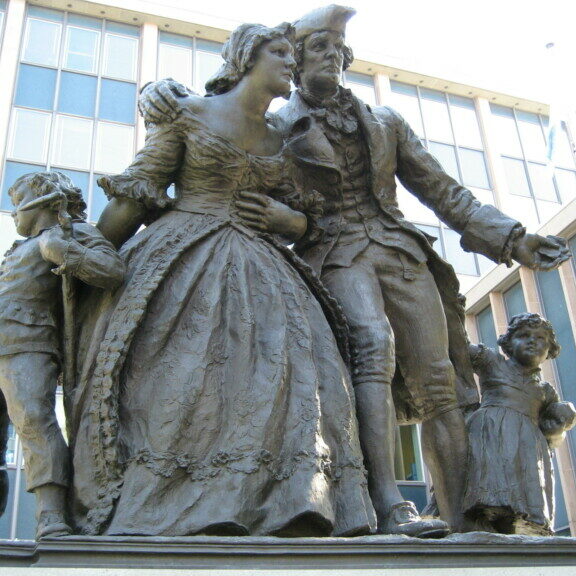
Self-Guided Tour: Loyalist Women of Cambridge
By MaryKate Smolenski, Tufts University Intern, June 2020
Download the tour here as a PDF with photos or without photos
Funding for this project was made possible through the generosity of the Massachusetts Society of the Cincinnati
For further reading, see: Who were the Loyalist Women of Cambridge? Introductory post and Part 1: Mary Browne Serjeant
Overview and History
Loyalists have often been described as selfist, elitist, and cowardly. However, Loyalists were a more diverse group who opposed revolting against England for a variety of economic, religious, emotional and political reasons. During the Revolution, Loyalists–including women– made up roughly 20-30% of the American Colonial population. Defining a Loyalist woman is complicated. Many women were deemed “Loyalists” because their male family members were considered loyal. Some women were more active and showed their support through activities like letter-writing, buying British goods, delivering intelligence, and resisting Patriots.
Cambridge was home to many early events in the American Revolution. In September 1774, the Powder Alarm took place (see first bonus stop on tour) and most Cambridge Loyalists relocated to Boston. Cambridge became the headquarters for George Washington, the Continental Army, and the Patriot Massachusetts government in 1775. The Siege of Boston lasted until March 17, 1776, when the British and Loyalists evacuated Boston. In September 1778, Massachusetts banished many Loyalists and later passed additional acts for confiscation of property. All of these events would impact the lives of Loyalist women. Some would never return to Cambridge.
The aim of this tour is to shed light on who the Loyalist women of Cambridge were. In addition to highlighting the stories of individual women, we hope to show how many of these women were tied to the greater British Atlantic world (particularly the Caribbean), slavery, the Anglican church, and large familial networks.
The Loyalist women we will discuss on the tour are all white. Many of their families owned plantations in the Caribbean and profited from enslaved labor both there and in Massachusetts. There were also African and African American Loyalists. In 1775, British Lord Dunmore issued a proclamation promising freedom to enslaved people if they supported the British, a promise which was later extended by the 1779 Philipsburg Proclamation. As a result, thousands of Black people of all ages and genders fled to the British side to escape enslavement. However, the British also allowed white Loyalists to continue owning their enslaved workers. The Book of Negroes contains the names of over 3,000 Black Loyalists who escaped to British lines and received their freedom and transportation out of New York in 1783. There are nineteen people from Boston listed, six of whom were women. None were specifically from Cambridge, so this tour does not explore the lives of any Black female Loyalists. However, the tour does seek to highlight the white Loyalist women’s ties to slavery.
Cambridge Loyalist women were deeply involved in dealing with the consequences of politics and war. They submitted Loyalist claims, ran businesses and households, delivered intelligence to the British, uprooted their lives, and tried to preserve their property and families. Their stories, and this tour, contribute to a fuller story of the American Revolution and of Cambridge.
Bonus 1st Stop: Powderhouse Square
Somerville, MA
Our tour begins with a bonus stop located in modern-day Somerville. In Powder House Square there is a stone magazine (building) that stored gunpowder from 1747 to 1774. This was the site of the Powder Alarm in September of 1774, which greatly affected many Loyalist women of Cambridge.
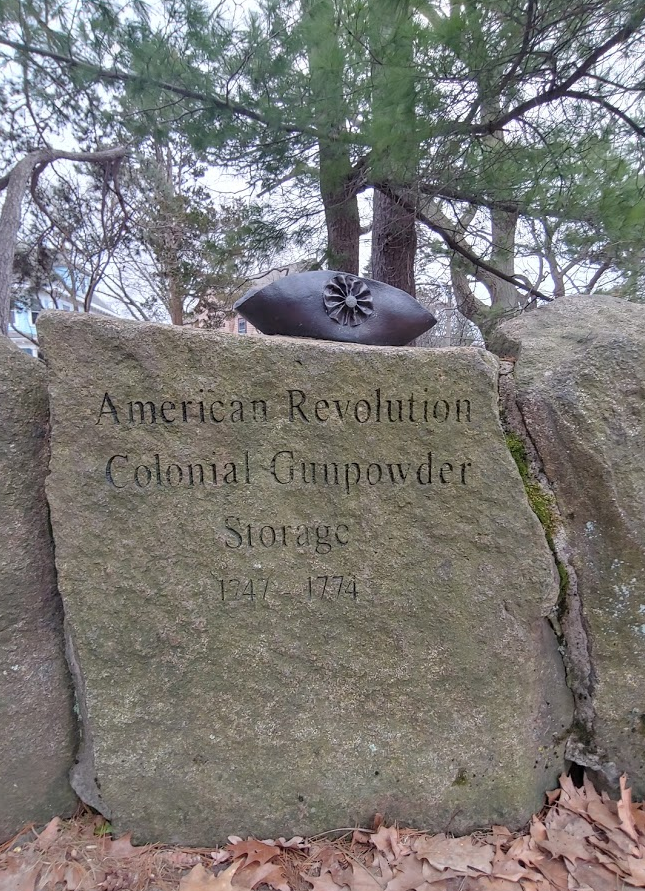
This incident began when William Brattle of Cambridge informed General Thomas Gage, via letter, about a store of gunpowder that he believed Cantabrigarians were planning to steal to build up local militias. General Gage sent troops to collect the gunpowder stored in the magazine. The structure still stands in Nathan Tufts Park in the Square and there is a small memorial to it.
Image courtesy of the author
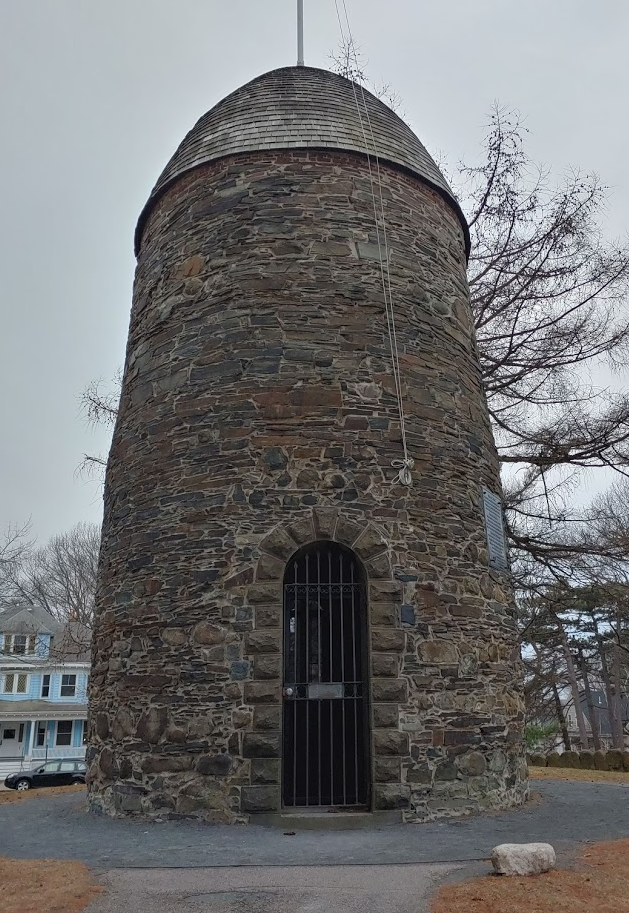
After the gunpowder confiscation, rumors spread that there had been bloodshed over the removal, which led to panic and, ultimately, thousands gathered on Cambridge Common. The crowd eventually marched down Brattle Street to the home (stop 9) of the Royal Lieutenant-Governor Thomas Oliver, husband of Elizabeth Vassall Oliver, and demanded his resignation from the royally-appointed governing body, the Mandamus Council.
Image courtesy of the author
Rebecca Phipps Lee’s husband, Joseph (stop 8), and Elizabeth Symmes Danforth’s husband, Samuel (stop 4), also resigned. These women undoubtedly feared for their families’ safety during this incident. Many Loyalist women left Cambridge following the Powder Alarm and sought safety in Boston where the British troops were quartered.
Stop 1: Apthorp House, 10 Linden Street
Anna Vassall Borland Knight (1735 – 1823)
The next stop is Apthorp House (currently owned by Harvard University), which was the home of Anna Vassall Borland Knight from 1765 to 1774. Following the 1774 Powder Alarm, Anna and her family fled to Boston. While there, her husband, John Borland, fell off a ladder and died in 1775. Their Cambridge house was seized by the Patriots and used as a prison for General Burgoyne in 1777.
Following her husband’s death, Anna was left living in besieged Boston as a widow with nine children. Fortunately for her, she had inherited a great deal of wealth from her husband and father, Leonard Vassall, who owned plantations in Jamaica. She had her father’s Braintree property where there were several enslaved workers, such as an enslaved coachman Pompey and his wife Vidaliato. Anna would have also owned slaves to run her Cambridge home.
Anna feared for the safety of her family in Boston and decided to move to England. Britain had set up a committee to hear claims from Loyalists about their services to the crown and losses due to the war, for which they would be financially compensated.
In 1777, Anna submitted a Loyalist claim and received £200 annually. In 1782, as the war was drawing to a close, she submitted another claim, asking to return to North America to see if she could recover her property, which likely included slaves as well as land.
Anna returned and recovered her house in Braintree (later sold to John and Abigail Adams). She remarried and lived the remainder of her life in Boston. She died a widow on June 20, 1823 at the age of 88 and was buried in the Borland family plot in the Granary Burying Ground in Boston, alongside her mother and her first husband. Her story reflects how some Loyalist women were able to return to North America; this was partially due to her familial connections in Massachusetts and her wealth from enslaved labor.
Brattle Street, aka “Tory Row”
“Seven families, who were connected by relationship, or lived in great intimacy, had here farms, gardens, and splendid mansions, and not far off orchards; and the buildings were at a quarter of a mile distant from each other. The owners had been in the habit of assembling every afternoon in one or another of these houses, and of diverting themselves with music or dancing, and lived in affluence, in good humour, and without care…”
-Baroness Frederika Charlotte Riedesel, 1777
Image courtesy of the author
Brattle Street was home to many Cambridge Loyalist families. Most were related through marriage or blood and included the Vassall, Phipps, Royall, and Oliver families. These families were predominantly Anglican and derived their wealth from Caribbean plantations and enslaved labor. They lived in grand colonial homes, serviced by enslaved staff; some homes and enslaved workers were later used by the Patriot army during the Siege of Boston (April 1775 – March 1776).
The street was named after Reverend William Brattle and his son, William Brattle, who was a military veteran and the man who incited the 1774 Powder Alarm. During the Patriot occupation of Cambridge, Washington nicknamed the street “Tory Row.” Tory was another name for Loyalist.
Stop 2: 42 Brattle Street
Katherine Brattle Wendell (1730 – 1821)
The first stop on Brattle Street is the home of William Brattle. During the 1774 Powder Alarm, William fled to Boston after it was discovered that he was the one who had alerted the British. At the time, his daughter, Katherine Brattle Wendell, lived in the home. The street was named after her family. Her grandfather, Reverend William Brattle of the First Church of Cambridge, owned at least one slave, a girl named Cicely who died at thirteen and was buried in the Old Burying Ground (stop 4).
Katherine had married John Mico Wendell of Boston and the couple had five children together. When John died in 1773, she returned to Cambridge. Her Loyalist father was the home’s legal owner and confiscation by the Patriots was very likely. During the Powder Alarm, the mob surrounded the home and broke windows. However, Katherine was determined to maintain the property. In August 1775, Thomas Mifflin, the Patriots’ quartermaster general, occupied the house during the siege of Boston. Katherine remained in the house with her daughter, Martha Fitch Brattle, and a guest, Abigail Collins.
Katherine worked to curry favor with the local and military officials, and won respect from the Patriots. Her father evacuated Boston with the British in March 1776 and sailed to Halifax, Nova Scotia, where he died in October of that year. His Boston home was confiscated and sold, but Katherine succeeded in preserving the Cambridge house. Her brother Thomas inherited the home when their father died. Katherine remained in Cambridge for the rest of her life and died in 1821.
Stop 3: Christ Church, 0 Garden Street
Mary Browne Serjeant (b. 1736)
Winwood Serjeant, minister of Christ Church from 1767 until the start of the war, was married to Mary Browne Serjeant. Childrearing and housekeeping would have occupied most of Mary’s time. The Serjeants did own at least one enslaved man; Mary’s parents in Portsmouth, New Hampshire, owned slaves as well. In 1775, Winwood–a Loyalist–was seized by the Patriots and, during his imprisonment, became paralyzed. When he was freed, Mary moved her husband and their young children (ages 9, 6, and 1) from Cambridge to Kingston, New Hampshire. Once there, however, they were met with anti-Loyalist sentiment and were forced to move again, this time to Newburyport, Massachusetts. They lost most of their belongings, including “one negro man.”
In 1778, Mary relocated her family to Bath, England. In 1780, her husband and son both died. While she grieved, she also had to think of how to support herself and her two daughters. Mary submitted multiple petitions to institutions that might assist her, including the Loyalist Claims Committee. Mary also sent power of attorney to agents in North America to recover her money. Eventually, she received an annual pension of £100. She longed to return to America but, since she would lose her government pension if she left England, she couldn’t afford to go home.
Mary felt alone; her fellow Cambridge Loyalists in Bath snubbed her, possibly because of her fall from wealth. Mary’s Patriot sister and brother-in-law, the Livermores, also ignored her letters. Her daughter Mary suffered from fits, but her daughter Elizabeth, who assisted in running the household, was a major comfort to Mary. After a final letter in 1789, information about Mary Serjeant Browne and her daughters trails off. It is likely that Mary spent the rest of her life in Bath, never to return to her native New England.
Stop 4: Old Burying Ground (Garden Street at Massachusetts Ave.)
Elizabeth Symmes Danforth (1710 – 1775
Next to Christ Church is the Old Burying Ground, which dates back to 1636. The cemetery holds the graves of Patriot soldiers (including two free African American soldiers), eight Harvard presidents, two enslaved women (the previously-mentioned Ceicily, owned by William Brattle, and Jane, owned by Andrew Bordman), and a few Loyalists.
Many Cambridge Loyalists were Anglican (Church of England). Henry Vassall, husband of Penelope Royall Vassall (stop 5), died in 1769 and was buried in a tomb under Christ Church. However, not all Loyalists attended Christ Church. William Brattle was a Congregationalist. Another non-Anglican Loyalist was Judge Samuel Danforth and his wife, Elizabeth Symmes Danforth. Elizabeth’s family had deep Puritan roots and her father was a Puritain pastor at Bradford’s Congregational First Church (modern-day Groveland, Massachusetts). She had married Danforth in 1726 and they had four children together.
During the 1774 Powder Alarm, the mob demanded that Elizabeth’s husband resign from his position on the Mandamus Council. Her elderly husband, then 76 years old, addressed the crowd of 4,000 on Cambridge Common and resigned. Following this incident, the Danforths did not flee to Boston but remained in Cambridge for the rest of their lives.
Elizabeth died on January 13, 1775 and her husband in 1777; the two are buried together in the Old Burying Ground.
As you walk to the next stop, 94 Brattle Street, you will pass by Cambridge Common where Elizabeth’s husband spoke to the Powder Alarm mob.
Stop 5: 94 Brattle Street
Penelope Royall Vassall (1724 – 1800)
This house was built in 1746 by Henry Vassall, the brother of Anna Vassall Borland Knight (stop 1); Henry’s wealth derived from Jamaican plantations and from several enslaved workers in Cambridge. His wife, Penelope Royall Vassall, was also from a wealthy family, the Royalls. Penelope was born in Antigua, where her family’s plantations were located; her father also owned land in Medford.
In 1742, she married Henry, bringing with her several enslaved people: Abba, Cuba, and four of Cuba’s siblings. Enslaved Cuba met Tony, Henry’s enslaved coachmen, and the two had several children together.
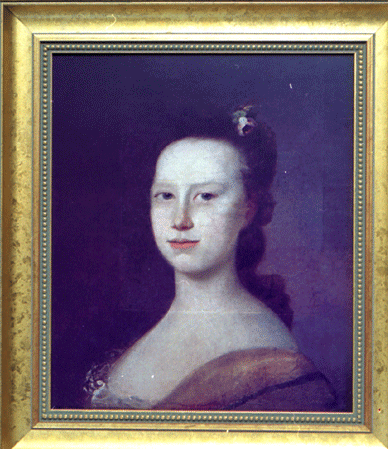
Henry passed away in 1769, leaving Penelope a widow. In addition to the Brattle Street home, Penelope had also inherited considerable wealth from her mother. Following Henry’s death, Penelope’s nephew, John Vassall (stop 6), purchased Cuba and two of her young sons, thereby separating the enslaved family.
Image courtesy of Cambridge and the American Revolution
Tony and two other children, James and Dorinda, remained with Penelope. During the 1774 Powder Alarm, Penelope and her enslaved workers would have seen the mob march down her street.
Penelope soon abandoned her Cambridge home and enslaved workers and moved to Boston, where she made arrangements to sail to Antigua. Before she left, she petitioned the Massachusetts Provincial Congress to allow her to take the belongings left in her home with her. She was permitted everything except for her medicine chest and any provisions that could be utilized by Patriots. While she was absent from Cambridge, her home was used as a hospital for the Continental Army. During the war, she and her daughter’s family lived in Antigua in reduced financial circumstances.
While Penelope’s Loyalist male relatives–her brother, Isaac Royall Jr., and her cousin, Joseph Royall–were banned from the state, she was able to return. When she died in 1800, Penelope was buried alongside her husband in the Vassall tomb in Christ Church.
Stop 6: 105 Brattle Street
Elizabeth Oliver Vassall (1741 – 1807)
The Vassall-Craigie-Longfellow House was the home of Elizabeth Oliver Vassall. Her father was Robert Oliver, who owned Antigua plantations and kept enslaved workers on his Dorchester property. Her brother was Lieutenant Governor Thomas Oliver. Elizabeth’s husband, John Vassall Jr., also derived his wealth from enslaved labor in the Caribbean and in Massachusetts.
As previously mentioned (stop 5), in 1769, her husband John purchased an enslaved woman, Cuba, and her two young sons from his aunt Penelope. The enslaved family came to live at 105 Brattle Street when Cuba was pregnant. Elizabeth and Cuba both gave birth to sons in May 1769, however, a few years later, Cuba’s son, Darby, was sold to a family in Woburn.
Image courtesy of Wikipedia
During the 1774 Powder Alarm, Elizabeth would have seen the mob march towards her brother Thomas’s house and feared for the safety of her family. Following this, the Vassall family removed to Boston and their Cambridge home was used as the headquarters for George Washington. They also left behind seven enslaved workers, including Cuba. The father of Cuba’s children, Tony, had also been left behind by Penelope Royall Vassall, and he joined Cuba. The enslaved couple eventually gained a pension from the Patriot government and owned a home in Cambridge.
Meanwhile, in November 1775, Elizabeth’s infant son Leonard died in besieged Boston. In 1776, she and her family relocated to Halifax and then to England. The Vassalls’ wealth allowed them to thrive in England and they remained there. Her husband submitted Loyalist claims and was compensated for their lost property, but denied his requested yearly pension (he made too much money). They maintained two homes, one in Bath and one in Clifton, and resumed their affluent lifestyle. Elizabeth passed away in 1807 and was buried in St. Paul’s Church Yard, Clifton. The family’s memorial there does not mention their Massachusetts origins.
Stop 7: 149 Brattle Street
Esther Quincy Sewall (1738 – 1810)
Esther Quincy Sewall lived at 149 Brattle Street with her husband, Jonathan Sewall, who served the Attorney General of Massachusetts from 1767 until 1775. Her father was Edmund Quincy, a merchant who was involved in several ventures, including the slave trade. Prior to the start of the American Revolution, Esther was close to several Patriot families; Abigail Smith Adams was her friend and cousin, and John Hancock was courting and later married her sister, Dorothy.
On the eve of the Powder Alarm, in September 1774, Jonathan Sewall was in Boston. Esther was home with their two young sons, at least one enslaved man, and at least two young law students who boarded there. She secured the home and gathered her household in her chamber. During the night, the mob arrived and demanded that Jonathan come out. Esther spoke to the crowd from a window, telling them her husband was not there and begging them not to harm her and her children. The crowd broke down the door, and the men in the home ran downstairs and fought with them. The mob ultimately dispersed after they were given wine to drink. Following this terrifying incident, Esther and her family relocated to Boston.
The Sewalls disliked living in besieged Boston. They travelled to Nova Scotia and then on to England, arriving in September 1775. In England, they lived in London and Bristol. Esther deeply missed her Massachusetts home and her Patriot friends and family. Jonathan was in despair over his losses, which likely distressed Esther as well. When John Adams was the U.S. Minister to England, Esther was able to visit with Abigail Adams. In 1787, Jonathan was appointed a judgeship in modern-day Canada, and the Sewalls left England and sailed to Halifax. Their sons also became prominent lawyers in Canada. When her husband passed away in 1796, Esther moved to Montreal, where she lived until her death in 1810.
Stop 8: 159 Brattle Street
Rebecca Phipps Lee (1727 – 1800?)
Today this house is the headquarters of the Cambridge Historical Society, but during the American Revolution it was the home of Rebecca Phipps Lee, daughter of Lieutenant Governor Spencer Phipps. Rebecca married Joseph Lee in 1755 and, in 1758, the Lees purchased the home and undertook renovations; for example, there is a record of their updating an upstairs bedroom by plastering over the faux paneling and adding figured wallpaper. Rebecca would have overseen the changes as part of her housekeeping duties. She attended services at Christ Church and socialized with the other Brattle Street families, including her sister, Mary Lechmere, who lived at 149 Brattle before the Sewalls purchased it.
In 1774, Joseph was selected to serve on the Mandamus Council. During the Powder Alarm later that year, the mob demanded Joseph’s resignation and he complied. The Lee family left Cambridge following the Powder Alarm to live in British-held Boston, and then later moved to Philadelphia and New Jersey. In 1777, they travelled to Cambridge to reclaim the house. They were successful and moved back to Cambridge. However, many of Rebecca’s friends and family would never return; her sister Mary relocated to Bristol, England like many other Massachusetts Loyalists. Rebecca remained in the house for the rest of her life and passed away around 1800.
Stop 9: 33 Elmwood Avenue
Elizabeth Vassall Oliver (1739 – 1776/1780?)
The Vassall-Craigie-Longfellow House was the home of Elizabeth Oliver Vassall. Her father was Robert Oliver, who owned Antigua plantations and kept enslaved workers on his Dorchester property. Her brother was Lieutenant Governor Thomas Oliver. Elizabeth’s husband, John Vassall Jr., also derived his wealth from enslaved labor in the Caribbean and in Massachusetts. The final house on “Tory Row” (the road originally curved down Elmwood) was the home of Elizabeth Vassall Oliver. Her father was John Vassall Sr., who made his money from Jamaican plantations. In 1760, Elizabeth married Thomas Oliver of Dorchester, whose family owned plantations in Antigua; the couple had six daughters: Ann, Elizabeth, Penelope, Mary, Lucy, and Frances.
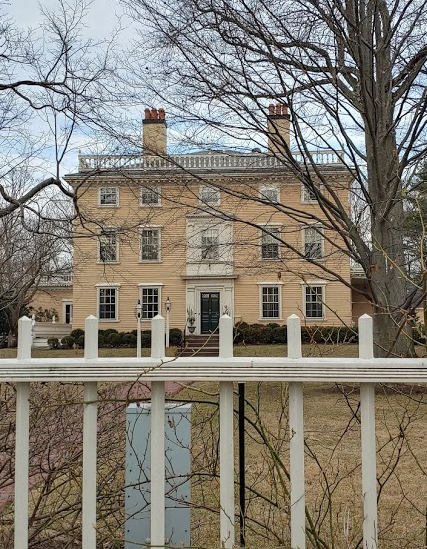
In 1766, they moved to Cambridge and built this home. Elizabeth’s brother, John Vassall Jr., lived down the street with his wife, also named Elizabeth (stop 6). The two families frequently socialized and sat in pews across from each other at Christ Church.
Image courtesy of the author
In 1774, Elizabeth’s husband Thomas became the Lieutenant Governor of Massachusetts. During the Powder Alarm later that year, a mob of 4,000 marched down Brattle Street and surrounded their home. Elizabeth was inside with her six daughters and feared for their safety. The mob demanded Thomas’s resignation from the Mandamus Council. At first he refused, but after hearing the mob calling for his blood and seeing the distress of Elizabeth and their children, he ultimately complied. The next day, the family quickly packed, left behind their home, and relocated to Boston.
When the British evacuated Boston in March 1776, the Oliver family went with them to Nova Scotia. From there, they boarded a ship with John Vassall’s family and travelled to England. Elizabeth passed away after they arrived there, although the exact date and cause are unknown. What is known is that Thomas travelled to Antigua in 1780 and remarried in 1781, so Elizabeth passed away sometime between 1776 and 1780. It is possible the stresses of living in a besieged city (infected with smallpox) or long voyages took a toll on her health.
Bonus Stop: Inman Square
Elizabeth Murray Campbell Smith Inman (1726 – 1785)
Inman Square is named after Loyalist Ralph Inman, who once owned the land on which it sits. Following Inman Street towards Cambridge City Hall, one can find the site of the Inman residence.
It no longer stands, but was located at what is now 15 Inman Street. During the Revolution, this house was home to Elizabeth Murray Campbell Smith Inman and her third husband, Ralph.
Image courtesy of Wikipedia
In 1771, she wed Ralph and they signed a prenuptial agreement. Originally from Scotland, Elizabeth was wealthy from her previous marriages and her own businesses; her brother James had helped to fund her businesses by selling three enslaved people. She also trained young women–including several relatives–in sewing and selling millinery.
When war broke out, Ralph and Elizabeth’s brother James were in Boston and remained there. Elizabeth stayed in Cambridge along with several relatives, and enslaved workers and/or servants, to prevent her property and crops from being confiscated. Patriot troops camped on the Inman property and Elizabeth allowed them to use part of the house.
Courtesy of Museum of Fine Arts, Boston
Ralph corresponded with her, often asking for money. One of her enslaved workers, Job, informed the troops that Elizabeth was a Loyalist and, as a result, they began to restrict her movements. This led to Elizabeth turning over more of the house to the troops; in return, Patriot General Israel Putnam provided her with a travel pass so that she could move about more freely. Only when the Battle of Bunker Hill raged nearby did she leave and relocate to her Milton property.
The Cambridge house was then fully taken over by the Patriots, but Elizabeth still visited to harvest her crops and left a few enslaved workers/servants on the property to protect it. Ultimately, the Inmans returned to their Cambridge home following the war, possibly thanks to Elizabeth’s efforts. Her brother, James, and other relatives became Loyalist exiles and she continued to write to them. She died in 1785 and was buried at King’s Chapel. For more information on Elizabeth’s life, see Elizabeth Murray: A Spirit of Independence in Eighteenth-Century America by Patricia Cleary.
Conclusion
The stories of Cambridge’s Loyalist women highlight the complexity of their lived experiences. Many women were affected by the Powder Alarm of 1774. They worked to gain financial support, save their homes, and maintain their families. Some, like Katherine Brattle Wendell and Elizabeth Murray Campbell Smith Inman, complied with the Patriots to save their property. Many were forced to leave their homes and flee with children and few belongings, like Mary Browne Serjeant. Some left Massachusetts and travelled to the Caribbean, Canada, and England. Others never left Cambridge or later returned. These women experienced disruption and loss, but were able to overcome challenges thanks to their familial networks and ties to the larger British Atlantic world.
Cambridge’s Loyalist women were deeply affected by politics, yet they did not have the ability to vote; in the eighteenth century, there were many ways for women to be involved in politics outside of suffrage. They expressed their opinions in letters, purchased British goods, and sought support and protection from the British government. Even if they did not choose Loyalism, the status of being deemed a Loyalist by others impacted them. They were targeted by mobs and were separated from friends and family.
Most, if not all, Cambridge Loyalists benefited from the institution of slavery. Many owned slaves in Massachusetts or the Caribbean; others engaged in the slave trade. The names of some Loyalists’ enslaved men and women are known, such as Cuba Vassall or Pompey, while others are lost. Their stories matter and deserve to be told as well. Hopefully, this tour has highlighted underrepresented voices of Loyalist women, and a few of their enslaved workers. The American Revolution has many nuances and a full understanding requires the inclusion of perspectives from the Patriots, Loyalists, and neutrals and from multiple genders, classes, and races. This tour is intended to be a starting point for further discussions about the Revolution from varying perspectives.
Sources
“Ann Vassall Borland, American Loyalist Claims, 1776–1835,” 1777. AO 12–13. The National Archives, Kew. https://www.ancestry.com/search/collections/canadaamericanloyalist/.
“An [account] of what is this day deliver’d to Mr John Borland & his lady Anna Borland the heiress to Leonard Vassall deceas’d… Boston, 13 Mar 1749/50., 1749.” Houghton Library, Harvard College Library. https://id.lib.harvard.edu/ead/d/hou01316c00027d/catalog. Accessed May 15, 2020.
An Historic Guide to Cambridge. Hannah Winthrop Chapter, National Society, Daughters of the American Revolution, 1907.
Batchelder, Samuel Francis. Christ Church, Cambridge: Some Account of Its History and Present Condition, Especially Prepared for Visitors, 1893.
Bell, J.L. “Attack on Jonathan Sewall’s House.” Boston 1775 (blog), September 1, 2019. http://boston1775.blogspot.com/search/label/William%20Brattle.
Bell, J.L. “George Washington’s Headquarters and Home- Cambridge, Massachusetts: Longfellow House – Washington Headquarters National Historic Site Historic Resources Study.” Department of the Interior, National Park Service, February 29, 2012. https://www.nps.gov/long/learn/historyculture/upload/Washington-Headquarters-HRS.pdf.
Bell, J.L. “The Big Mystery of Lt. Gov. Thomas Oliver.” Boston 1775 (blog). Accessed June 2, 2020. http://boston1775.blogspot.com/2008/04/big-mystery-of-lt-gov-thomas-oliver.html.
Bell, J.L. “The Mifflins’ Marriage.” Boston 1775 (blog), September 18, 2014. http://boston1775.blogspot.com/2014/09/the-mifflins-marriage.html.
Bell, J.L. “On the Night Before the Powder Alarm.” Boston 1775 (blog), September 2, 2019. https://boston1775.blogspot.com/2019/09/on-night-before-powder-alarm.html.
Calder, Charles Maclear. John Vassall and His Descendants. [Hereford, Eng. : S. Austin], 1921. http://archive.org/details/johnvassallhisde00cald.
Cambridge Historical Society. “East Apthorp House.” Accessed May 14, 2020. https://historycambridge.org/Cambridge-Revolution/Apthorp%20House%20edited.html.
Cleary, Patricia. Elizabeth Murray: A Woman’s Pursuit of Independence in Eighteenth-Century America. University of Massachusetts Press, 2000.
Cleary, Patricia. “The Elizabeth Murray Project.” The Elizabeth Murray Project, November 21, 2013. https://web.csulb.edu/projects/elizabethmurray/EM/index.html.
Historic Buildings of Massachusetts. “Henry Vassall House (1746),” December 1, 2008. http://mass.historicbuildingsct.com/?p=107.
Jackson, Robert Tracy. “History of the Oliver, Vassall and Royall Houses in Dorchester, Cambridge and Medford.” The Genealogical Magazine, January 1907. https://play.google.com/store/books/details?id=DJMtAAAAYAAJ&rdid=book-DJMtAAAAYAAJ&rdot=1.
“John Vassall, American Loyalist Claims, 1776–1835,” 1784. AO 12–13. The National Archives, Kew. https://www.ancestry.com/search/collections/canadaamericanloyalist/.
“Jonathan Sewall, American Loyalist Claims, 1776–1835,” 1784. AO 12–13. The National Archives, Kew. https://www.ancestry.com/search/collections/canadaamericanloyalist/.
Kenney, Michael, and Gavin W. Kleespies, eds. Rediscovering the Hooper-Lee-Nichols House. The Cambridge Historical Society, 2010.
Lacy, Katherine. “Cultural Landscape Report: Illustrated Site Chronology Fro Adams National Historic Site, Quincy, Massachusetts.” Cultural Landscape Report. Boston, MA: Olmstead Center for Landscape Preservation, National Park Service, October 1997. http://npshistory.com/publications/adam/clr-1997.pdf.
“Mary Browne Serjeant, American Loyalist Claims, 1776–1835,” 1784. AO 12–13. The National Archives, Kew. https://www.ancestry.com/search/collections/canadaamericanloyalist/.
Mass Moments. “Loyalist Despairs at British Defeat.” Accessed May 31, 2020. https://www.massmoments.org/moment-details/loyalist-despairs-at-british-defeat.html.
National Park Service. “Though Dwelling in a Land of Freedom.” National Park Service. Accessed May 5, 2020. https://www.nps.gov/articles/though-dwelling-in-a-land-of-freedom.htm.
Oxford Bibliographies- Atlantic History. “The Society for the Propagation of the Gospel in Foreign Parts.” Accessed November 18, 2019. https://www.oxfordbibliographies.com/view/document/obo-9780199730414/obo-9780199730414-0067.xml.
Paige, Lucius R. History of Cambridge, Massachusetts, 1630-1877, Volume 2: Genealogical Records. Jazzybee Verlag, 1877. https://books.google.com/books?id=HhExDwAAQBAJ&printsec=frontcover&source=gbs_ge_summary_r&cad=0#v=onepage&q&f=false.
“Penelope Royall Vassall (1724 -1800).” Accessed June 1, 2020. https://www.findagrave.com/memorial/173110082/penelope-vassall.
Radcliffe, Michael. “Elizabeth Murray.” History of American Women (blog), September 28, 2008. https://www.womenhistoryblog.com/2008/09/elizabeth-murray.html.
Rogers, Mary Cochrane. Glimpses of an Old Social Capital (Portsmouth, New Hampshire): As Illusrated by the Life of the Reverend Arthur Browne and His Circle. Boston: The Merrymount Press, 1923. https://books.google.com/books?id=oTZXAAAAMAAJ&source=gbs_navlinks_s.
Rosenberg, Chaim M. The Loyalist Conscience: Principled Opposition to the American Revolution. McFarland, 2018.
Sankovitch, Nina. American Rebels: How the Hancock, Adams, and Quincy Families Fanned the Flames of Revolution. St. Martin’s Publishing Group, 2020.
Stark, James H. The Loyalists of Massachusetts And the Other Side of the American Revolution. Boston, MA: W. B. Clarke Company, 1907. https://www.gutenberg.org/files/39316/39316-h/39316-h.htm.
“Serjeant Family Letters, 1769-1840 | Cambridge Historical Society.” Accessed March 20, 2020. https://historycambridge.org/research/serjeant-family-letters-1769-1840/.
Sprague, William Buell. Annals of the American Episcopal Pulpit. Robert Carter & Brothers, 1859. https://books.google.com/books?id=21PvxuRXKzsC&dq=mary+browne+serjeant&source=gbs_navlinks_s.
“Thomas Oliver, American Loyalist Claims, 1776–1835,” 1784. AO 12–13. The National Archives, Kew. https://www.ancestry.com/search/collections/canadaamericanloyalist/.






